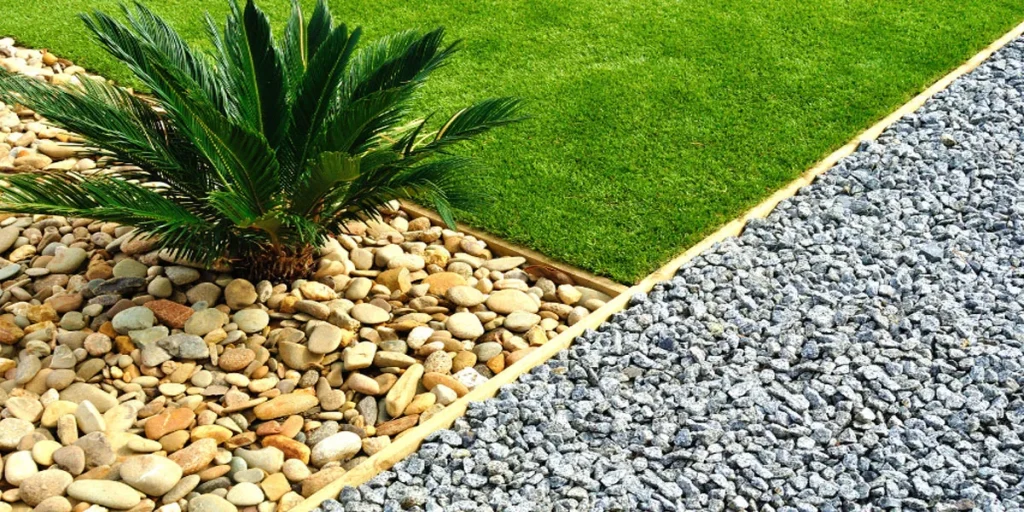A yard of gravel typically weighs between 2,400 to 2,900 pounds. The exact weight can vary based on the material’s density and moisture content.
Gravel is a versatile material commonly used in various landscaping and construction projects. Its weight per cubic yard is an essential factor for transportation and project planning.
Understanding this can help you estimate the number of loads needed, calculate delivery costs, and ensure your handling equipment is adequate.
Note that the type of gravel — whether pea gravel, crushed stone, or another variant — affects the weight.
Seasons also influence the moisture content in the gravel, potentially increasing its weight.
Mindful of these elements, professionals and DIY enthusiasts can approach their gravel-related projects with improved accuracy and efficiency.

What Determines A Gravel Yard’s Weight?
Ever wondered why a yard of gravel weighs differently at times? Multiple factors influence the weight of a yard of gravel.
Understanding these can help you estimate how much you need for your project.
Let’s dive into the specifics of grain size, composition, and moisture content, which are critical in determining the weight of gravel.
Grain Size And Composition
The size and type of grains in your gravel yard play a huge role in its weight. Different sized grains pack together in various ways.
Smaller grains fill gaps between larger ones, leading to a denser and heavier yard of gravel.
Composition matters too. Heavier minerals like basalt make the gravel weigh more. Here’s a quick glance:
- Fine gravel: Denser packing, heavier
- Coarse gravel: More air space, lighter
- Rock type: Some rocks are heavier
Moisture Content Variability
Moisture also affects a yard of gravel’s weight significantly. Dry gravel is lighter. When wet, the water between the grains adds extra weight.
Weather conditions can change the moisture level in gravel. It can be tricky to calculate, but it’s essential to consider. Check out the impact of moisture:
| Condition | Impact on Weight |
|---|---|
| Dry Gravel | Lighter |
| Wet Gravel | Heavier due to water |
Remember, when you measure a yard of gravel, the grain size, composition, and moisture are your main concerns.
Types Of Gravel And Their Respective Weights

Garden paths, driveways, and landscaping accents often feature the timeless elegance of gravel.
Yet, the crucial question remains: “How heavy is a yard of gravel?” Explore the enchanting world of gravel types and understand what tips the scales for your project needs.
Pea Gravel Vs. Crushed Stone
Pea gravel, small and smooth, often colors gardens with shades of brown and gray.
Weighing roughly 1,200 to 1,700 pounds per cubic yard, its uniform shape makes it a favorite for playgrounds and walkways.
Crushed stone, angular and rugged, demands more weight. One cubic yard can press the scale from 2,400 to 2,900 pounds. Its sturdiness lays a solid foundation for driveways and base layers.
River Rock Vs. Marble Chips
River rock’s smooth edges evoke streambeds and serene landscapes. Weights range from 2,300 to 2,700 pounds per yard. Its larger size fits perfectly around ponds and for drainage solutions.
Marble chips bring a touch of luxury. Lighter than river rocks, they tip the scales at about 2,500 pounds per yard. Their reflective surface brightens spaces and deters weeds.
| Type of Gravel | Weight Per Cubic Yard |
|---|---|
| Pea Gravel | 1,200 – 1,700 lbs |
| Crushed Stone | 2,400 – 2,900 lbs |
| River Rock | 2,300 – 2,700 lbs |
| Marble Chips | 2,500 lbs |
- Weight varies by the type of gravel.
- Choose gravel based on the project’s need.
- Density and size affect weight.
Understanding each gravel type’s weight empowers gardeners and builders alike. Select the right gravel to ensure durability and ease of maintenance for your outdoor haven.
Calculating The Weight Of Your Gravel Yard

Embarking on a landscaping project or paving a driveway requires precise calculations. Knowing the weight of a yard of gravel influences transportation and costs.
Various factors affect this weight. Gravel type, moisture content, and gravel depth all play a role. Let’s explore how to calculate gravel weight accurately.
Standard Formulas Used
To start, a yard of gravel typically refers to a cubic yard. One cubic yard of gravel can weigh between 2,400 to 2,900 lbs.
Yet, weight vary based on gravel type. A standard formula helps determine a close estimate:
Weight = Volume x Density
The density of common gravel is generally appx. 1.4 tons per cubic yard. Use this as a baseline for calculations.
Adjusting For Depth And Coverage Area
Not all projects use a full cubic yard of gravel. Calculating for different depths and areas is vital for accuracy. This involves two steps:
- Determine the square footage of your coverage area (Length x Width).
- Multiply this by the desired depth in feet (inches divided by 12).
This gives the volume of gravel needed in cubic yards. For consistency, adjust the weight according to depth.
Use these methods to estimate the gravel weight for your yard. Remember, exact weight can only be measured with professional scales.
Transportation And Handling Of Gravel
Getting your yard of gravel from the store to your project location takes careful planning. Gravel can be heavy and handling it requires specific equipment and safety measures.
Understanding how to transport and handle gravel ensures your project proceeds smoothly.
Equipment For Moving Heavy Loads
Quality tools are vital for moving a yard of gravel efficiently and safely.
- Wheelbarrows make small distances manageable.
- Dump trucks transport large volumes over long distances.
- Skid steers or front-end loaders shift heavy loads quickly on-site.
- Forklifts and pallet jacks may assist in warehouse movement.
Safety Measures During Transport
It’s crucial to stay safe while moving gravel. Follow these steps to prevent accidents:
- Wear protective gear: Safety glasses, gloves, and steel-toe boots are essential.
- Mind your lifting technique: Lift with your legs, not your back.
- Secure your load: Ensure the gravel is stable to avoid spills during transport.
- Check equipment: Always verify that vehicles and tools are in good condition.
Practical Applications And Estimating Needs
Understanding the weight of gravel by yard is pivotal for home and commercial projects. Knowing the exact quantity ensures a smooth operation from landscaping to large-scale construction.
Gravel is sold by the cubic yard, which is a 3-dimensional measure of volume. Estimating the amount of gravel needed for a project can be simplified by using certain calculations and guidelines.
Landscaping And Construction Uses
Gravel has a broad range of applications in both landscaping and construction. These include:
- Driveways: A top layer over base rock, providing stability and improved drainage.
- Walkways: Reliable footing and aesthetic appeal make gravel ideal for walkways.
- Drainage Systems: Gravel aids in water management around buildings and gardens.
- Concrete Mix: It’s a critical component, adding strength to the concrete structure.
How Much Gravel For Project X?
To estimate the gravel for a specific project, consider the area’s dimensions and the desired gravel depth. Here’s a guide for common projects:
| Project | Area (sq ft) | Depth (in) | Gravel Needed (cubic yards) |
|---|---|---|---|
| Small Patio | 100 | 3 | 1.11 |
| Walkway | 200 | 2 | 1.23 |
| Garden Base | 150 | 4 | 2.22 |
To calculate this, simply multiply the area’s square footage by the depth desired, and then divide by 27, as a cubic yard contains 27 cubic feet.
Remember that gravel’s weight may affect transportation and handling. Use a gravel calculator online for an easy estimate.
Whether you’re setting up a new flower bed or laying the foundation for a pathway, an accurate gravel estimation is crucial.
FAQs About the Weight of a Yard of Gravel
What Determines A Yard Of Gravel’s Weight?
The weight of a yard of gravel depends on the gravel’s density, moisture content, and composition. Typically, a cubic yard of gravel weighs about 2,400 to 2,900 pounds (1. 3 to 1. 6 metric tons).
Is Gravel Weight Consistent Across Types?
No, gravel weight varies by type. For instance, pea gravel is lighter than crushed stone. Material density and particle size affect overall weight, with a cubic yard ranging from 2,400 to 2,900 pounds.
How Much Does A Cubic Yard Of Gravel Cover?
A cubic yard of gravel typically covers about 100 square feet at a standard 2-inch depth. Coverage decreases as depth increases, so adjustments are necessary for deeper applications.
Can You Transport A Yard Of Gravel In A Pickup?
Yes, a standard pickup truck can transport a yard of gravel. However, it’s essential to check the truck’s payload capacity to avoid overloading, which is dangerous and could lead to penalties.
Conclusion
Understanding the weight of a yard of gravel ensures accurate project planning and budgeting.
On average, a cubic yard of gravel weighs approximately 2,400 to 2,900 pounds, varying with moisture content and material type.
As we’ve explored, factors such as gravel size and density play crucial roles in determining weight.
For precise calculations, consider the specifics of your chosen gravel and consult with a supplier.
Remember, arming yourself with this knowledge leads to smarter, more efficient purchases and project outcomes.
Resources:
https://www.usgs.gov/centers/national-minerals-information-center/construction-sand-and-gravel-statistics-and
https://www.fhwa.dot.gov/construction/pubs/ots15002.pdf
